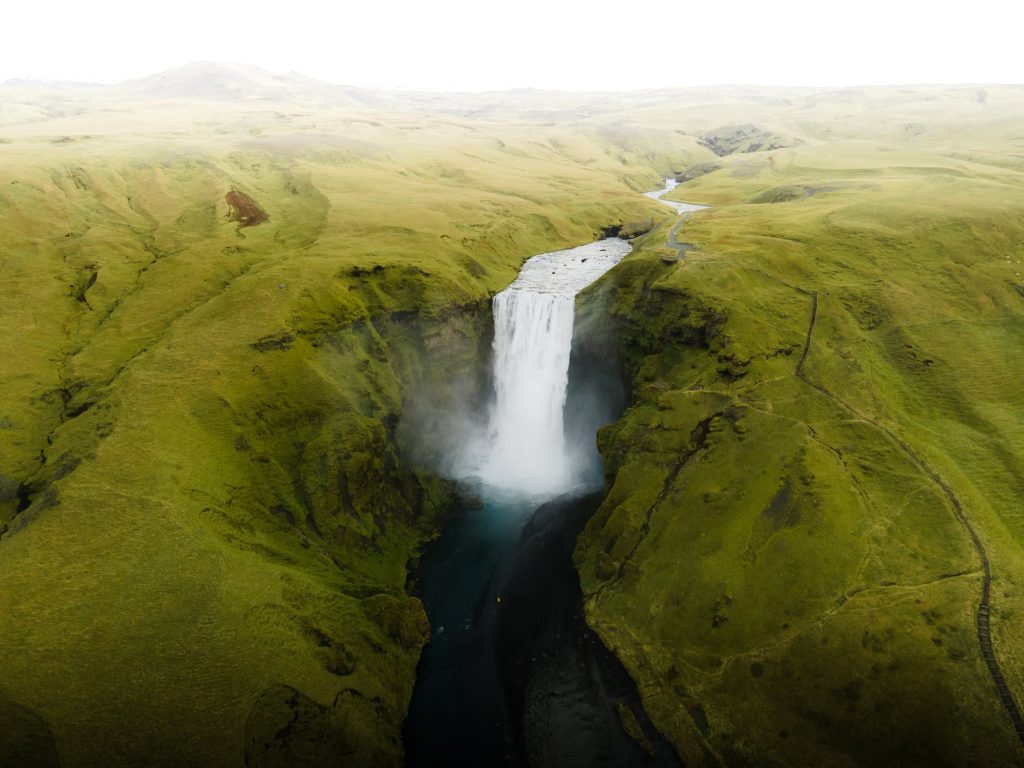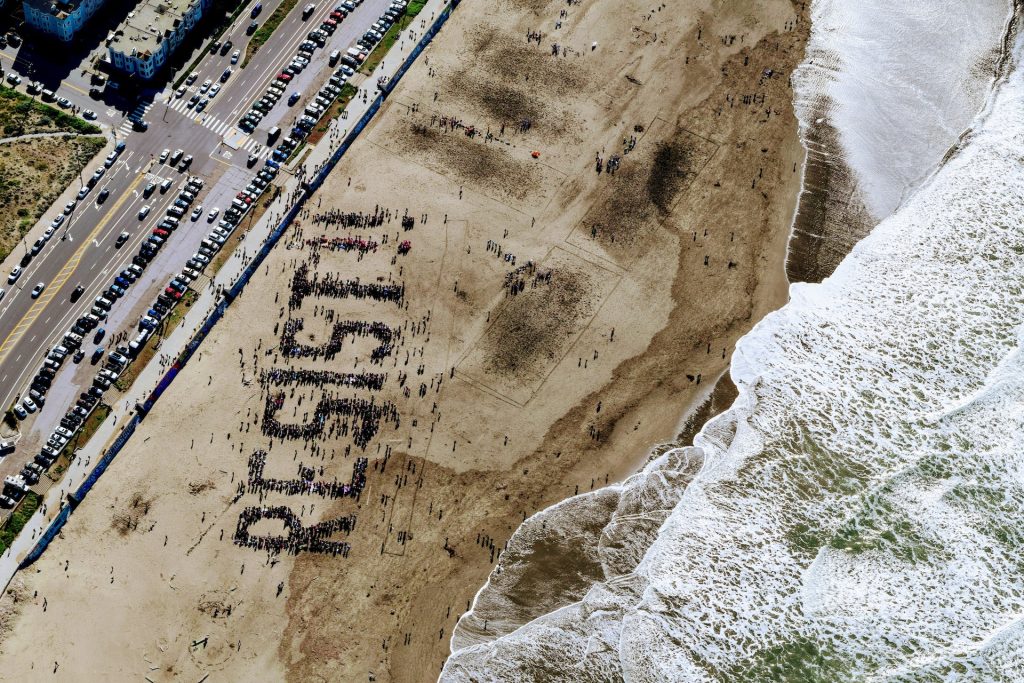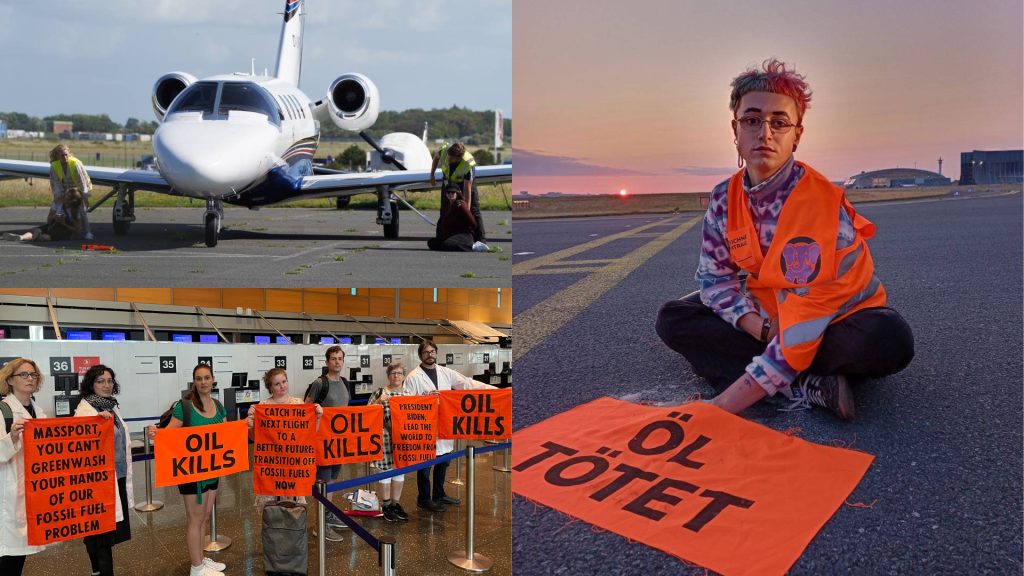
by DGR News Service | Oct 9, 2024 | ACTION, Direct Action, The Problem: Civilization
Editor’s note: DGR does not support the renewable energy transition aspect of such a treaty.
By Alexandria Shaner September 11, 2024 / Waging Nonviolence

An unprecedented alliance of climate groups is targeting airports on three continents to demand a binding treaty to end fossil fuels by 2030.
A new international coalition is disrupting airports to make one demand: the adoption of a treaty to end fossil fuels by 2030.
Under the banner Oil Kills, small groups of activists have occupied airport departure lounges, plane cabins, terminals, tarmacs and roads across three continents — and they aren’t done yet. Here are the numbers so far: 500 people, 31 airports, 22 groups, 166 arrests, 42 people on remand in prison — all in support of their one demand.
The coalition formed when members of Extinction Rebellion, the A22 Network and Stay Grounded began reaching out to other groups globally. What resulted was an unprecedented alliance of civil resistance groups focused on the sustained disruption of airports — a key pillar of the fossil fuel economy.
Unifying aims, collective strategy and diverse tactics
All Oil Kills participants are committed to nonviolent direct action and to the central demand, but from there, individual creativity and context has led to an array of actions. The resulting structure is a decentralized yet cohesive power bloc with unified aims that becomes more than the sum of its parts, rather than a lowest common denominator coalition.
Each participating group has adopted the central demand that governments must work together to establish a legally binding treaty to stop extracting and burning oil, gas and coal by 2030, as well as supporting and financing poorer countries to make a fast, fair and just transition. But each local group also brings its own unique knowledge and demands which are in turn supported by the coalition. Futuro Vegetal in Spain, for example, focuses on the imperative to adopt a plant-based agri-food system while Students Against EACOP in Uganda demand a stop to the East African Crude Oil Pipeline — and all stand in solidarity with one another.
Each group also brings its own creative tactics, from airport glue-ins, to plane occupations, to spray-painting terminals, to street marches. “The airports don’t know what to expect because we don’t even know exactly what to expect from each other — it’s beautiful and effective,” said a coalition member who requested to remain anonymous for legal reasons.
After the initial whirlwind of actions in July, with 37 arrests over the first two days alone, disruptions have continued steadily across three continents, with especially relentless activity in Germany where Letzte Generation has held several actions in multiple airports.
On Aug. 9, Students Against EACOP in Uganda joined the Oil Kills campaign, planning a peaceful march to the parliament in Kampala and the delivery of a petition demanding an end to the East African Crude Oil Pipeline, and for their government to sign the treaty to end fossil fuels.
But the police mounted roadblocks to stop the march from starting, and arrested 45 student activists on public buses and their three bus drivers on arrival. Two students managed to slip away and regrouped, reaching the parliament building with petition in hand before also being violently arrested.
Kamya Carlos, a student at Kyambogo University and spokesperson for Students Against EACOP, connects the inequitable and ecocidal nature of today’s airline industry to its origins in neocolonial extractivism. “New oil, gas and coal infrastructure continues to exacerbate the climate crisis. As the global temperatures hit their tipping points it is clear that projects such as the East African Crude Oil Pipeline should never be constructed in the first place,” he said. “These projects, which end up being used almost exclusively by rich people and polluting the atmosphere, should never be allowed by right thinking members of society. We demand the government to sign a fossil free treaty and call an end to EACOP.”
Even though police repression represents a major threat, on Aug. 27, 20 climate activists and persons affected by the oil pipeline came back out in another peaceful march to petition Uganda’s Ministry of Energy. They were again violently dragged from the street by police in fatigues and held on remand until Sept. 6, when the court finally granted their release on bail. All 20 have been ordered to appear for a hearing on Nov. 12.
“The resilience under extreme repression shown by Students Against EACOP is an inspiration and metaphor for the Oil Kills movement,” said Jamie McGonagill, an Oil Kills member from XR Boston. “We refuse to die.”
You can’t arrest a rising sea
As of this writing, 22 Oil Kills activists remain in custody in Uganda, six in Germany and 14 in the U.K. Speaking to the increasing criminalization of dissent, McGonagill explained that “draconian responses that imprison nonviolent climate activists, especially as we’ve seen lately in the U.K. and in Uganda, show that the authorities misunderstand us. They will not stop us. We will just get more and more creative.”
Oil Kills is not alone in facing repression. On Aug. 8 in New York City, a 63-year-old grandfather and professional cellist, John Mark Rozendaal, was arrested and hit with a criminal contempt charge, carrying a maximum sentence of seven years in jail, for performing Bach’s “Suites for Cello” at Citibank’s headquarters. Rozendaal was participating in the Summer of Heat campaign to pressure Citibank to divest from fossil fuels through sustained nonviolent civil disobedience. Connecting this case to the burgeoning international movement, U.N. Special Rapporteur on Human Rights Defenders Mary Lawlor, in following Rozendaal’s case, has expressed her “strong concern” at the severity of the charges.
In a disturbing trend that has become the new normal in Italy, peaceful eco-activists are being branded a “danger to security and public order,” served with specious charges, banned from cities without trial, and criminalized under anti-terrorist laws intended to prosecute the Mafia.
Last week in the U.K., several high profile journalists and activists affiliated with the movement for Palestinian liberation were arrested in a sweep by counter-terrorism police for their opposition to genocide. They have been held under Section 12 of the U.K.’s Terrorism Act, which outlaws support for a “proscribed organization.” Such an application of the law would mean that you can go to jail for 14 years for expressing an opinion.
XR NYC organizer Meg Starr, a long-time Puerto Rican solidarity activist and coordinator of the XR Allies sub-circle, noted that the links between genocide and ecocide — in Palestine and elsewhere — are becoming clearer and more important to emphasize. “Our targeting of Citibank,” Starr commented, “included a focus on Citi’s major support of the Israeli military as part of their role as the world’s leading financier of oil and gas expansion.”
Roger Hallam, co-founder of Extinction Rebellion and Just Stop Oil, was recently sentenced to five years in prison for making a speech over Zoom in what is being called a “grotesque sham-trial.”
“Repression is not a gradual process, it leaps out at you and takes you off guard,” he warned from his prison cell. “Do you remember the Solidarity leaders in Poland? They were invited into talks with the Polish government but when they got to the meeting, they were arrested in one fell swoop and imprisoned for years. You don’t think it will happen to you and then it does.”
Hallam’s message is that we can expect more repression, but that authorities must also expect more resistance. “You can’t negotiate with physics, with a thousand peer-reviewed articles,” he wrote. “Just Stop Oil reminds us what resistance, that far-off folk memory relegated to Netflix, actually looks like in the present moment. Thousands of arrests, hundreds of imprisonments and a five-year sentence for making a speech.”
In a statement announcing a pause in international actions to allow politicians to consider their demands, Oil Kills echoed the realism of Hallam’s framing. “The facts are clear, we are flying towards the obliteration of everything we know and love. Continuing to extract and burn oil, gas and coal is an act of war against humanity. …To know these facts and yet to have no plan to end the extraction and burning of oil, gas and coal is reckless and immoral.”
They point out that while activists sounding the alarm and demanding change are increasingly criminalized, our politicians are actually the ones who are complicit in the greatest crime in human history. “Whether those in charge realize that they are engaging in genocide is not the question. For this is how it will be seen by the next generation and all future generations,” Oil Kills warned. “For now we are taking a pause, but governments must take heed: you cannot arrest your way out of this, just as you cannot imprison a flood or serve injunctions on a wildfire.”
Oppose oil injustice, propose mobility justice
Stay Grounded is a network of individuals, local airport opposition and climate justice groups, NGOs, trade unions, initiatives fostering alternatives to aviation like night trains and organizations supporting communities that struggle against offset or projects to develop so-called “sustainable aviation fuels.” Importantly, Stay Grounded goes beyond affirming the conclusion that business as usual is not an option, and stands for a 13-step program to transform transport, society and the economy to be just and environmentally sound.
“Flying is the fastest way to fry the planet so it’s key to start by cutting pointless and unfair flights like private jets or short haul flights,” said Inês Teles, a spokesperson for Stay Grounded and an Oil Kills member. “Our actions disrupting airports should be a shock to the system that is driving us towards climate catastrophe.”
In summary, Stay Grounded’s program begins with a positive vision for justice. It includes advice for achieving a just transition, shifting to other modes of transportation, developing economies of short distances and changed modes of living, as well as strong political commitments for land rights, human rights and climate justice.
Their program then details what must be avoided — obvious yet important items like growing the harmful air travel industry, including infrastructure expansion, loopholes and privileges for aviation, and common greenwashing pitfalls like carbon offsetting, biofuels, and illusory technocentric fixes.
Though Stay Grounded’s aims are more specific to the air travel industry than Oil Kills’ unifying demand for a treaty to end fossil fuels by 2030, coalition members are able to build on these positive aims, utilizing leadership from frontline communities affected by the air travel industry. Sharing and even cross-pollinating pro-social and ecologically healthy programs, in addition to opposing destructive practices, has been an effective way of galvanizing and sustaining support across diverse movements and communities.
Covering activism isn’t activist
The choice to focus on disrupting the air travel industry in order to pressure governments to adopt a fossil fuel non-proliferation treaty is as bold as the demand itself. Much of the media’s reaction so far has been unsurprisingly harsh, condemning the disruptions as “not the right way to do it.” Very little critical analysis has been audible above the din, but that doesn’t mean critical analysis isn’t happening.
It turns out, if you actually listen to them, that Oil Kills activists take strategy extremely seriously — after all, they’re knowingly putting their own freedom on the line through their actions. That is not a decision to be taken lightly, especially in today’s legal context. While news coverage of their “stunts” has circulated widely, what about the reasons behind their actions and assessments of their impact?
Covering climate activism well is a critical part of getting the climate story right. Too often journalism focuses on protesters’ tactics and not the problems they’re drawing attention to or the arguments they’re making. In a recent roundtable discussion, author, journalist and activist Bill McKibben urged fellow journalists to consider that, “we can serve our audiences better, treating activists as the newsmakers they are, rigorously evaluating their arguments as we would a public official.”
Journalists often shy away from foregrounding activists as sources of information and analysis for fear of being perceived to be more “activist” than “objective.” This framing is entirely misleading however, and can more accurately be explained as the pressure to avoid platforming those seeking to change the system in deference to those whose position exists to maintain the system. Why is a politician or a business owner an appropriate subject, but not an activist? There is no objectivity in this, but there are salaries and awards.
The myth that journalism must keep activism at arms length also misses the point that many of these ordinary people taking action are some of the best informed on the biggest news story of our time: the climate and ecological emergency. Activists have been speaking on climate science and policy for decades, many have even been personally affected by ecological disaster, but they have been almost exclusively ignored by the mainstream press. After decades of fossil fuel industry gaslighting, it turns out the activists have been right all along. It’s past time to hear these people out as legitimate subjects and newsmakers, able and deserving to speak about their work and their areas of expertise.
Why target air travel?
First, the obvious answer: oil kills. And the air travel industry is very, very oily. Aviation is by far the mode of transport with the biggest climate impact. If aviation was a country, it would be one of the top 10 emitters.
Emissions from aviation are rising more rapidly than any other sector of the economy. The number of aircraft and the number of passenger-miles flown is expected to double over the next 20 years. If left unchecked, they could consume a full quarter of the available carbon budget for limiting temperature rise to 1.5 C.
Second, oil isn’t extracted equitably, burned equitably, and neither does it kill equitably. At the turn of the millennium, less than 5 percent of the world’s population had ever sat in an aircraft. But it is mostly non-flyers who bear the brunt of the climate crisis and the negative effects of airport expansion like land grabbing, noise, particle pollution and health issues. Communities in the Global South that have barely contributed to the crisis are affected most. Indeed, well before the repression of the Oil Kills coalition, climate activists — especially in Latin America — have faced what is being termed “ecopoliticide”: the targeted and strategic murder of those who dare take action.
Stephen Okwai, a project affected person who has joined the movement to stop the EACOP pipeline in Uganda, feels there is now greater risk in inaction than in protesting. A project affected person, or PAP, is a legal term for the people directly affected by land acquisition for a project through loss of part or all of their assets including land, houses, other structures, businesses, crops/trees and other components of livelihoods. They are legally owed compensation, but in the case of Okwai and others affected by EACOP, there has been no such justice.
“Currently most of us in western Uganda are being disturbed,” he explained. “You cannot know when the rain is going to start and when it will stop yet most of these people are farmers. The effect of this oil project is greatly impacted on the people.”
After he was arrested during the Aug. 27 march in Kampala, Robert Pitua, a member of Oil Kills, Students Against EACOP, and a PAP, said that, “Livelihood restoration programs [have been] insufficient, and now we cannot manage to restore the initial livelihoods we had. Most people are given unfair and inadequate compensation.” This structural and planned destruction of hundreds of communities has left PAPs no choice but to resist, and is the source of a common refrain in Students Against EACOP’s demonstrations: “We refuse to die.”
This leads to the third reason to target aviation. The Oil Kills uprising is highlighting that the problem of aviation is part of a bigger story of injustice — it is in fact a pillar helping to hold up a system of injustice. The air travel industry is contrary to the need to eliminate fossil fuel use; it is tied to the military-industrial complex; and it is connected with the undue influence of big business on public policy, including trade, economic development and climate.
Aviation remains fossil fuel dependent, yet the industry promotes false solutions such as new aircraft technologies, which do not yet exist, in order to continue to pollute for profit. Offsets and biofuels fail to reduce emissions while endangering food supplies, biodiversity and human rights.
“Not only is the air travel industry a cornerstone of globalized fossil capitalism, but it is also a symbol of inequity,” Jamie McGonagill said. “By disrupting a major column of the system, we aim to disrupt the system itself.”
Rather than plentiful data and common sense reasoning, it is more often a powerful underlying consciousness that has spurred many to action. When asked why it was necessary to disrupt air travel across Europe and North America, Just Stop Oil spokespeople replied, “because governments and fossil fuel producers are waging war on humanity. Even so-called climate leaders have continued to approve new oil, gas and coal projects pushing the world closer to global catastrophe and condemning hundreds of millions to death.”
The Oil Kills coalition has rallied around reality with the seriousness it deserves, refusing dystopia by disrupting it, and demanding a clear and urgent path towards repair. “Our leaders from wealthier countries must seek a negotiating mandate for an emergency Fossil Fuel Treaty,” said coalition members in an Aug. 14 statement. “They also need to immediately finance and support poorer countries to make a fast, fair and just transition.”
https://drive.google.com/file/d/1QbDnrL9HSbGzuq9r89WmdcJVNMQQ1mfK/view?usp=sharing
Assessing impact
If increased media attention on the climate and ecological emergency is any indicator of success, and it is, the Oil Kills uprising is punching well above its weight. “Oil Kills” was mentioned over 2,900 times in the press during the first week of the campaign. The Fossil Fuel Non-Proliferation Treaty initiative has also never attracted so much media attention worldwide, with an increase of over 1,000 percent in mentions from the week prior to the campaign’s launch. Oil Kills actions drew comments from politicians, government officials and from the vice president of Norwegian oil giant, Equinor. For only 500 people spread out over three continents, they have indeed been hard to ignore.
It is true, not all publicity is created equal — but pleasing the general public is not always the priority. In a recent article, Mark Engler and Paul Engler, coauthors of “This is an Uprising,” discussed why protest works even when not everyone likes them. They explain that a very common result is that, when asked about a demonstration that makes news headlines, respondents will report sympathy for the protesters’ demands, but they will express distaste for the tactics deployed. They will see the activists themselves as too noisy, impatient and discourteous.
The coauthors, both experienced activists and resistance scholars, point out that this is actually an age-old dynamic, and one addressed eloquently by Martin Luther King Jr. in his renowned 1963 “Letter from a Birmingham Jail.” They explain that, “this letter was written not as a response to racist opponents of the movement, but rather to people who professed support for the cause while criticizing demonstrations as ‘untimely’ and deriding direct action methods. ‘Frankly I have yet to engage in a direct action campaign that was ‘well timed’ in the view of those who have not suffered unduly from the disease of segregation,’ King quipped. But confronting these criticisms, he made the case for why the movement’s campaigns were both necessary and effective.”
In a similar vein, Oil Kills participants, like medical student Regina Stephan who recently took action at the Berlin airport with Letzte Generation, feel they have no choice but to act: “Just yesterday, the state of Lower Saxony gave the green light for new gas drilling off Borkum,” Stephan said. “That can’t be true! As long as our decision-makers work hand in hand with the fossil fuel companies and put profit before human life, I’m standing here — on the tarmac — and I can’t help it!”
Joining in this sentiment, Anja Windl, who took action at Stuttgart airport said very succinctly: “As long as our livelihoods are being systematically destroyed, our protests will not stop.”
Importantly, Oil Kills participants are not demanding that everyone utilize the same tactics. Rather, these activists are urging others to join the climate justice movement in diverse ways. Anja continued, “if you also want to campaign for an end to fossil fuels, you don’t have to sit on an airfield like I did: Just come to a Disobedient Assembly near you!”
In recent years, there has been considerable research published that attempts to measure radical flank effects and track the polarizing effects of movements. Mark Engler and Paul Englers’ analysis cautions that, “while there are limits to how much protest impacts can be precisely quantified, the cumulative result of such research, in the words of one literature review, is to point to ‘strong evidence that protests or protest movements can be effective in achieving their desired outcomes,’ and that they can produce ‘positive effects on public opinion, public discourse and voting behavior.’” They conclude that both the historical experience of organizers and recent studies provide backing for the idea that “support for a movement’s issue can grow, even when a majority of people do not particularly like the tactics being used.”
Finally, success cannot be fully measured by public opinion, especially when the strategy is to trouble public consensus. Oil Kills has been very clear that they are not acting in order to sooth or please anyone — they are intentionally sounding the alarm as a way of empowering people to act. By treating the climate crisis as a crisis, and reacting accordingly, activists are, in a sense, giving other people permission to do the same and showing them how. It’s like when someone is real with you and that makes you feel like you can be real too — and we all need to get real, real fast. The spell of complacency is like the tranquilizer that helps walk a cow to slaughter. Oil Kills is shouting, “wake up and live!”
In a debrief by the Oil Kills campaign on Aug. 16, they addressed the public: “it is time to face reality: no one is coming to save us. There is no free pass, no shelter from the coming storm. Our best chance of survival is to resist. To join the growing numbers of ordinary, everyday people, from across the globe who are refusing to stand by while hundreds of millions of innocent people are murdered.”
Offering a pathway forward out of doom, Oil Kill’s messaging has remained crystal clear: “The climate crisis will not end until every single country has phased out fossil fuels, [and] those who bear the greatest responsibility and have the greatest capacity must do the most … In this time of crisis, we expect our governments to work collaboratively, as we have done, and negotiate a Fossil Fuel Treaty to end the war on humanity before we lose everything.”
The next rebellion is coming
Coming back down from the hugeness of our crisis and into ourselves as individuals often causes a feeling of paralysis, especially for the majority of people not yet interconnected within communities of resistance and solidarity. But there have been actions where small groups or even lone activists have held up an Oil Kills banner and received media coverage and support because they are part of a global campaign which can’t be ignored. Every single contribution adds to that.
In a Sept. 6 letter to climate activist prisoners of conscience, Naomi Klein wrote, “In a world that was right-side up, you would be celebrated as the ones who helped break the spell that is setting our world on fire. In truth, your actions could still do that, if enough people know about them.”
It continues to be an urgent and essential task to ensure that more and more people do know about Oil Kills and other manifestations of resistance, but it is also evident that the world’s elites already understand the threat that these actions represent — the threat of mass uprising. That threat is precisely why nonviolent direct action in defense of planetary life is being criminalized so viciously.
Klein continued, “Movements against climate arson are already converging with movements against genocide and unfettered greed. The next wave of rebellion is coming. Along with the tankers, I see it clearly on the horizon.” The Oil Kills uprising and fellow movements around the world have placed their bodies between those tankers and our shared future to say, “here, and no further.”
If enough of us line up behind them, their actions could very well lead the way to an adoption of a treaty to end fossil fuels by 2030 — that remains to be won. What is for certain is that their actions are troubling the autopilot system, disrupting the mechanics of fossil-capital’s death march and creating desperately needed space to pursue alternate routes. Whatever else lies on the horizon, their contributions are already impacting the world in ways we cannot yet know, but will be unlikely to forget.
This article is co-published with ZNetwork.org.
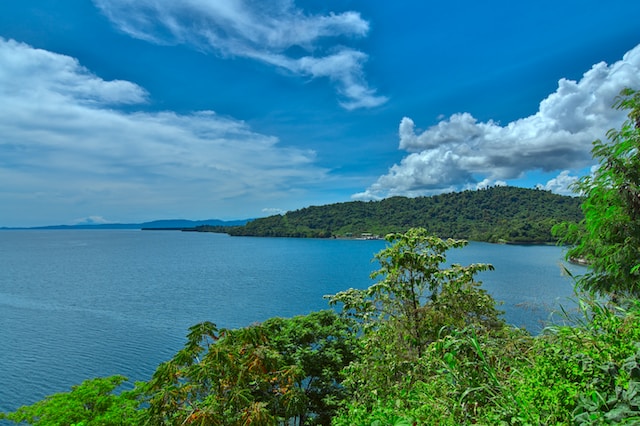
by DGR News Service | Nov 27, 2023 | Biodiversity & Habitat Destruction, Colonialism & Conquest, Mining & Drilling, NEWS
Editor’s Note: The Halmahera Island in Indonesia is the only known home to the Hongana Manyana tribe. Unfortunately, it is also the home to vast reserves of nickel. Mining companies are now evading the indigenous rights and ecological rights of the inhabitants of the island, as well as of the island herself, to steal the nickel. The nickel is going to be used for manufacturing electric cars. The following piece is taken from Survival International.
Nickel Mining Threatens Uncontacted Hongana Manyana Tribe in Indonesia
By Survival International
Guardians of their forest
The Hongana Manyawa – which means ‘People of the Forest’ in their own language – are one of the last nomadic hunter gatherer tribes in Indonesia, and many of them are uncontacted.
They have a profound reverence for their forest and everything in it: they believe that trees, like humans, possess souls and feelings. Rather than cut down trees to build houses, they make their dwellings from sticks and leaves. When forest products are used, rituals are performed to ask permission from the plants, and offerings are left out of respect.
The Hongana Manyawa root their whole lives to the forest, from birth to death. When a child is born, the family plant a tree in gratitude, and bury the umbilical cord underneath: the tree grows with the child, marking their age. At the end of their lives, their bodies are placed in the trees in a special area of the forest that is reserved for the spirits.
If there is no more forest, then there will be no more Hongana Manyawa.
Providing for themselves almost entirely from hunting and gathering, the Hongana Manyawa are nomadic; setting up home in one part of the forest before moving on and allowing it to regenerate. They have unrivalled expertise in the Halmahera rainforest, hunting wild boar, deer and other animals and maintaining a close connection with the sago trees – now threatened by deforestation from mining – which provide their main source of carbohydrate. They also have incredible medicinal knowledge and can treat many sicknesses with local plants, although this has become increasingly difficult following the new diseases brought by forced contact and resettlement in villages.
It’s more convenient for me to keep moving because the food is much more diverse and available, I can go hunting regularly. Permanently staying in the village is very uncomfortable and there is a lack of food.
Avoiding contact to stay alive
The arrival of the mining companies is just the latest threat to the Hongana Manyawa and their land. In recent decades, Indonesian governments have repeatedly tried to force contact onto the Hongana Manyawa, with the aim of stopping their nomadic way of life and evicting them from their ancestral forest home. They say this is to “civilize” them: they have tried to settle the Hongana Manyawa and have built Indonesian-style houses for them. The Hongana Manyawa say these new houses, with roofs made of metal sheets rather than palm leaves, made them feel “like animals in a cage”.
https://www.survivalinternational.org/tribes/honganamanyawa
One Hongana Manyawa woman told Survival:
We are so happy living by the forest with different kinds of meat and food, where we can collect roof materials so we can replace the zinc roof the government has built for us.
As with uncontacted tribes the world over, forced contact has proved disastrous for the Hongana Manyawa. They were immediately exposed to diseases to which they had no immunity – from the late 1970s to the early 1990s, terrible outbreaks of diseases which the Hongana Manyawa refer to as “the plague” affected the newly-settled villages, leading to widespread suffering and even death.
We had many different diseases when first settled, some of the sickness led to deaths, some people had fever that went on for days and nights and endless coughing for days and even weeks.
The contacted Hongana Manyawa also serve as convenient scapegoats for the police, who frequently blame them for crimes they have had nothing to do with. Several of them have been imprisoned for murders they did not commit and have languished in jail for many years.
It’s better to live in the forest so we don’t get accused of these things. We feel unsafe and many of the men moved into the forest and then came to get their wives and families. Some are deep in the forest…they are deeply traumatized.
Far from being respected for their unique and self-sufficient ways of living, the Hongana Manyawa experience severe racism and are regularly described by Indonesian officials and the media as ‘primitive’. There is a widespread belief that they would benefit from ‘integration’ into wider society: a belief that comes with disastrous and deadly consequences.
Many Hongana Manyawa are now living in government-built villages. Many others – traumatised by the government’s forced settlement attempts, like other peoples around the world who have experienced forced contact – have returned to their forest.
The uncontacted Hongana Manyawa have made it clear time and time again that they do not want to settle or have outsiders coming into their forest. They are very much aware of the dangers – including fatal epidemics of disease – which forced contact brings. As with the uncontacted Sentinelese tribe of India, it is little wonder that they are defending their lands and shooting arrows at those who force their way in.
But now they face the threat not just of being forced out of the forest that sustains them, but of seeing it all destroyed by corporations rushing to provide a supposedly ‘sustainable’ and ‘environmentally friendly’ lifestyle to people thousands of miles away.
https://player.vimeo.com/video/879389461?h=5199b980ee
‘Green’ mining threatens the lives of uncontacted tribal people
The greatest threat to the Hongana Manyawa today comes from a supposedly ‘green’ industry.
Their rainforest sits on lands rich in nickel, a metal increasingly sought after as an ingredient in the manufacture of electric car batteries. Indonesia is now the world’s largest producer of nickel, and Halmahera is estimated to contain some of the world’s largest unexploited nickel reserves. Nickel is not essential for these batteries, but now that the nickel market is booming, mining companies are homing in and tearing up huge swathes of rainforest.
The uncontacted Hongana Manyawa are on the run. Without their rainforest, they will not survive. These cars are marketed as ecofriendly alternatives to fossil fuel powered cars, but there is nothing ecofriendly about the way nickel is being mined in Halmahera.
It goes without saying that uncontacted tribes cannot give their Free, Prior and Informed Consent to exploitation of their land – which is legally required for all ‘developments’ on Indigenous territories under international law.
Nevertheless, Weda Bay Nickel (WBN) – a company partly owned by French mining company Eramet – has an enormous mining concession on the island which overlaps with Hongana Manyawa territories. WBN began mining in 2019 and now operates the largest nickel mine in the world. Huge areas of rainforest which the Hongana Manyawa call home have already been destroyed. The company plans to ramp up the mining to many times its current rate and operate for up to 50 years.
If we don’t support the fight for their forest, my uncontacted relatives will just die. The forest is everything, it is their heart and life. My parents and siblings are in the forest and without support they will die. Everything in the forest is getting destroyed now – the river, the animals, it is gone.
The Indonesian government claims that nickel mining is “critical for clean energy technologies” yet coal-fired power stations are being constructed at IWIP to process the nickel. The International Energy Agency estimates that 19 metric tons of carbon are released for every metric ton of nickel smelted and there is evidence from a similar project in Sulawesi of this leading to respiratory diseases for locals. Not only is this mining (accompanied by roads, smelters and other huge industrial projects) devastating the Hongana Manyawa’s rainforests, it is also polluting the air and damaging the rivers. The processing of nickel is often highly toxic, involving a host of chemicals which produce almost two metric tons of toxic waste for every metric ton of ore processed.
Survival is fighting against false solutions to the climate crisis, which are destroying Indigenous lands and lives.
They are poisoning our water and making us feel like we are being slowly killed.
Eramet, Tesla and connected companies
International companies are involved, directly or indirectly, in the mining of uncontacted Hongana Manyawa land.
WBN is a joint venture between several companies, but French company Eramet is part-owner and responsible for the mining itself. Eramet prides itself on its environmental and human rights credentials, claiming that it will “set the standard” and “be a benchmark company” when it comes to human rights. Yet it continues to mine on the territory of the uncontacted Hongana Manyawa.
Survival has learned that German chemical company BASF is also planning to partner with Eramet to build a refining complex in Halmahera and that a possible location for this may be on uncontacted Hongana Manyawa territory. This would be devastating for the uncontacted Hongana Manyawa in the area, who are already in hiding from mining.
Survival has been told that uncontacted Hongana Manyawa are now fleeing further and further into the rainforest, traumatized by the attacks on their forests and way of life.
Trees are gone and replaced with the big road, where giant machines go in and out making noise and driving the animals away.
Tesla, the world’s largest electric vehicle company, has signed contracts worth billions of US dollars to buy Indonesian nickel and cobalt for its batteries. Its CEO Elon Musk has also had high level negotiations with the Indonesian government to open an electric car battery factory in the country. Indonesia’s President Joko Widodo has even offered Tesla a ‘nickel mining concession.’
Tesla’s Indigenous rights policy states: “For all raw material extraction and processing used in Tesla products, we expect our mining industry suppliers to engage with legitimate representatives of indigenous communities and include the right to free and informed consent in their operations.”
Yet Tesla has now signed deals with Chinese companies Huayou Cobalt and CNGR Advanced Material, both of which have links to nickel mining in Halmahera. While supply chains are secretive and often obscure, Tesla’s interests in Indonesia and the scale of the planned mining in Halmahera make it possible that nickel mined from Halmahera could well end up in Tesla cars.
I do not give consent for them to take it…tell them that we do not want to give away our forest.
Demand for electric cars is driving the destruction of uncontacted people’s lands.
Rather than destroying yet more of the natural world, and the people who defend it, in the name of combating climate change, we should be supporting uncontacted tribes to defend their rainforests and their land rights; they are the guardians of the green lungs of the planet.
We the Hongana Manyawa, do not want a mining company to come, because it will destroy our forest. We will protect this forest as much as we can. If the forest is destroyed, where will we live?
Take Urgent Action for the Hongana Manyawa
The Hongana Manyawa are running out of forest and running out of time. They desperately need international support to stop the destruction of their homelands before it’s too late.
The Hongana Manyawa’s land rights must be recognised. Survival is calling for the declaration of an emergency zone for the uncontacted Hongana Manyawa. Around the world, Survival has successfully campaigned for the land rights of uncontacted tribes, defending them from outsiders bringing in deadly diseases and devastating development projects which could destroy them.
We are calling for:
– Eramet and the other companies mining in Halmahera, to immediately abide by international law and stop mining and other developments on the lands of uncontacted tribal people.
– Tesla and other car companies to publicly commit to ensure that none of the nickel or cobalt they buy ever comes from the lands of the uncontacted Hongana Manyawa in Halmahera.
– The Indonesian government to establish an ‘Uncontacted Tribe No-Go Zone” to protect the uncontacted Hongana Manyawa and their territories.
With your support, the territories of the uncontacted Hongana Manyawa can be protected from mining so that they can continue to live as they choose on their own land.
I want to share my knowledge with my grandchildren and those who want to learn how to eat and live in the forest.
Please tell Tesla to pledge that none of the minerals they buy ever comes from the lands of uncontacted Indigenous people in Halmahera – and let the mining companies, and the Indonesian authorities, know you’ve done so.
Sign the pledge here: https://act.survivalinternational.org/page/124732/action/1
Photo by pisauikan on Unsplash

by DGR News Service | Oct 23, 2023 | Biodiversity & Habitat Destruction, NEWS
Editor’s Note: Since the 2009 climate conference in Copenhagen, states and corporations alike have relied on the assumption that energy companies can be persuaded to rethink their business and initiate a transition process towards “renewable” energy and engagement in the “green” economy. That reliance has only increased since the climate talks in Paris in 2015.
Carbon trading and REDD+ are only some examples. In this scheme, every country gets a quota of carbon emissions. Heavily industrialized countries, instead of trying to meet the quota, can pay to exceed the quota. This fund is then used to reimburse less industrialized countries who emit less carbon than their quota.
In other words, they get paid to not deforest. While it may seem like a win-win situation, it is difficult to justify how this scheme actually helps reduce carbon emissions. This article from 15th September 2023 highlights some of the problems with the carbon credit system.
By Jessica Corbett/Common Dreams
“Biodiversity, the climate, and Indigenous people or local communities are losing out on what should have been a system to drive meaningful financial flows to the forest conservation projects that so desperately need it,” said one expert.
Echoing previous warnings from climate advocates and studies, an environmental watchdog on Friday released research from experts at the University of California which shows that trying to offset fossil fuel emissions with popular forest carbon credit projects “is a pipe dream.”
As the new Berkeley Carbon Trading Project assessment—funded by Carbon Market Watch (CMW)—explains, “The voluntary carbon market generates credits, each nominally equivalent to one metric ton of carbon dioxide reduced or removed from the atmosphere, from a wide range of projects around the globe.”
Carbon credits don’t stop deforestation
Critics have long argued that carbon credit schemes are “false solutions” that harm poor communities where such projects are based and enable companies worldwide to greenwash their polluting activity rather than implementing reforms or investing in action to actually combat deforestation and the climate emergency.
“Reducing Emissions from Deforestation and Forest Degradation (REDD+) is the project type that has the most credits on the voluntary carbon market—about a quarter of all credits to date,” the assessment details. “These projects pay governments, organizations, communities, and individuals in forest landscapes (primarily tropical ones in the Global South) for activities that preserve forests and avoid forest-related greenhouse gas (GHG) emissions.”
Over the past two decades, more than $3 billion has been poured into REDD+ and nearly half a billion carbon credits have been awarded, yet “deforestation is still continuing at an alarming rate,” the report notes. Berkeley researchers’ analysis of four methodologies that have generated almost all REDD+ credits—under Verra, the largest voluntary carbon market registry—revealed that estimated GHG emissions reductions were dramatically exaggerated.
“We found significant over-crediting from all of the factors we reviewed, the core causes of which are a combination of incentives and uncertainty,” said Barbara Haya, who led the research. “Everyone involved in the voluntary carbon market, from the buyers and sellers of credits, to the registries who write the rules and the auditors who enforce them, all benefit from more credits.”
“Large uncertainty in climate benefit calculations creates many opportunities for market participants to choose assumptions that inflate credits issued,” Haya added. “Drawing on all evidence, we conclude that REDD+ is ill-suited for carbon offsetting.”
As a CMW briefing published with the assessment summarizes:
- Project baselines are significantly overestimated, the research found, leading to the creation of carbon credits that represent imaginary emission reductions.
- Similarly, leakage is systematically underestimated by projects, which make use of flexibilities provided to them by the methodologies to downplay the risk of deforestation moving to areas outside of their project.
- The creation of low-quality carbon credits is further fueled by exaggerated estimates of the quantity of carbon stored within the trees that are protected by projects.
- The risk that the trees protected by REDD+ projects will die in the future is also drastically underestimated by projects, which again use methodological flexibility to misrepresent the real deforestation threat that forests will face in the future.
- Finally, the safeguards implemented by Verra are weak, do not protect communities from harm, and are not properly upheld by the validation and verification bodies.
Business over conservation projects
Verra released a lengthy response to the new assessment, which welcomed “the insight of the broader scientific and environmental community into our work on nature-based solutions,” but also said that “it is important to note that the vast majority of findings and recommendations from this research align with extensive and systematic work to update the Verified Carbon Standard (VCS) Program that Verra has carried out over the last two years.”
Inigo Wyburd, a CMW policy expert on global carbon markets, said that “we welcome Verra’s willingness to engage with our research and hope that it will take on board our findings and implement all of our recommendations.”
“Businesses are offsetting their emissions on the cheap by buying low-quality carbon credits connected to forest protection projects in the Global South,” the expert added. “When only 1 in every 13 carbon credits represents a real emissions reduction, their action is lost in the forest.”
Meanwhile, as Gilles Dufrasne, CMW’s policy lead on global carbon markets, highlighted, “biodiversity, the climate, and Indigenous people or local communities are losing out on what should have been a system to drive meaningful financial flows to the forest conservation projects that so desperately need it.”
“Offsetting should be axed,” he argued. “It cannot work in its current form, and carbon markets must evolve into something different. The focus should be on getting money to the right place, rather than getting as many credits as possible.”
As Patrick Galey, senior fossil fuels investigator at Global Witness, pointed out on social media Friday, the new research was released as the African nation Liberia is preparing to sign an offsetting agreement conceding 10% of its territory to Blue Carbon, a private company in the United Arab Emirates led by a member of an Emirati royal family.
Middle East Eye reported late that month that the deal for “control of one of the most densely forested territories” on the continent “would violate a number of Liberian laws, including the 2019 land rights law.” Additionally, as CMW policy expert Jonathan Crook told the outlet, “there’s no clarity as to what will be done to calculate what emission reductions have taken place.”
IndoMet in the Heart of Borneo, CC BY 2.0 via Wikimedia Commons
DGR conducted its annual fundraiser on Ecology of Spirit. If you have missed it, you can view it here. You can also visit our auction for paintings, books, brownies and conversations. The auction will remain open till October 31.
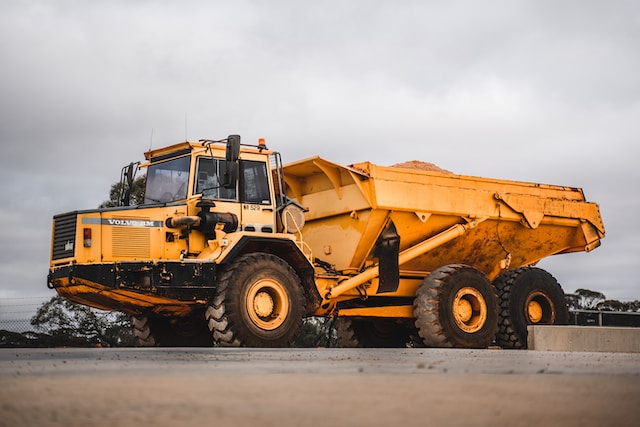
by DGR News Service | Jun 5, 2023 | ACTION, Mining & Drilling
Editor’s Note: Any alternative to fossil fuel is embraced as “green.” These include the so-called alternatives that require the destruction of the natural world on par with the destruction by fossil fuel. DGR has always stood against these false solutions. Instead, we stand with the real solutions, i.e. a complete halting of the industrial civilization and a return to a regenerative system.
The following article is written by Arno, and was originally published on the DGR France website. It is translated by Benja. It discusses the damage done by lithium mining, a core element of batteries for electronics, including electric cars.
By Arno/DGR France (Translated by Benja)
Focused on the fight against climate change, most environmental movements forget about other ongoing environmental disasters that are just as important, if not more so. One of the most serious is undoubtedly the destruction of biodiversity. Worse, in their frantic race to stop climate change – or rather in their frantic race to find alternative energies to carbon-based energies, and thus maintain the standard of living of Westerners and ensure the good health of the industrial machine in a context of climate change – they are doing everything to initiate an energy transition by promoting the development of so-called “green” energies, which are however very damaging to the planet.
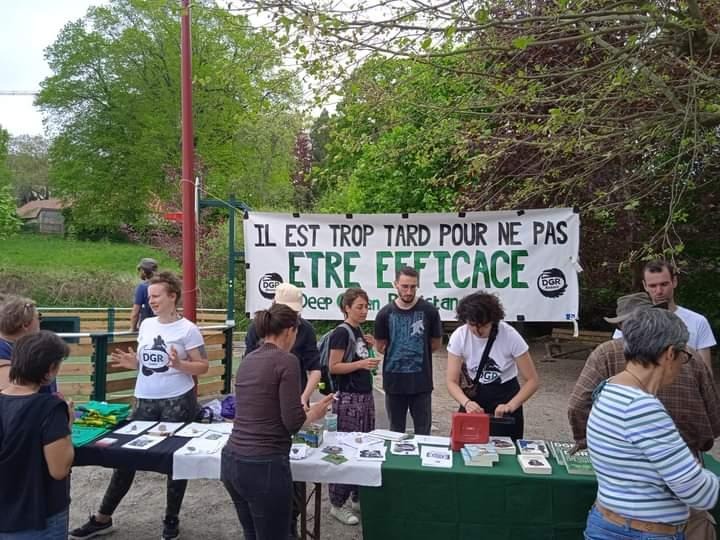
Two weeks ago, DGR France was on the site where a lithium mine is planned to create the batteries that are essential for the operation of machines powered by “green” energy. This would be a local extraction, which would also allow France to be less dependent on distant imports. In short, from the point of view of environmentalists, it is a double victory.
However, there is nothing to celebrate. The site in question is a magnificent old forest, of which nearly a hundred hectares will have to be logged for the installation of the mine. What’s more, this forest is located in the Puy-de-Dôme, the water tower of France. From this forest flow many rivers that feed the region, springs and wells. In summer, when the rivers are almost dry, which is increasingly common with climate change, the water table replenishes the rivers so that they never run dry, allowing the maintenance of aquatic life. Unfortunately, by digging deep to extract the rock (granite), the water table will drop below the level of the rivers. In summer, the water table will not be able to feed the rivers. Worse, it is the rivers, who’s level is already very low, that will end up emptying themselves into the water table.
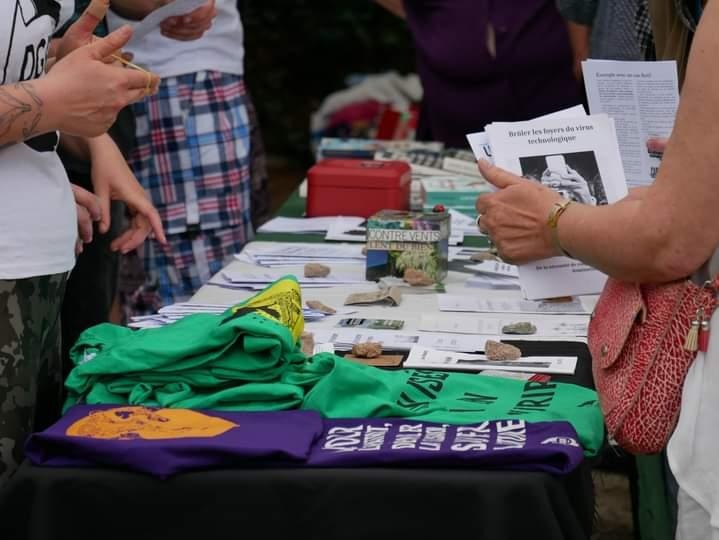
But that’s not all. Lithium is found in a specific rock, mica, which makes up 0.5% of granite. The mine will therefore extract phenomenal quantities of granite to reduce it to powder in order to get its hands on the mica. To do this, the operator will build huge basins in which the granite will be mixed with thousands of liters of chemicals to isolate the mica. The mica, once recovered, will be sent with water in a pipeline, whose implementation will ravage other natural areas of the region, to end up in a second plant that will be created for the occasion. The mica will then be immersed in very powerful baths of acids and bases, at very high temperatures, to finally obtain the precious lithium. It goes without saying that these on-site operations will consume phenomenal quantities of water, which will be pumped directly back into the aquifer, or at least what is left of it
Once you’ve taken the mica, you’re left with the rest of the granite, 95.5% of the chemical-soaked rock, which will then be put back underground. For centuries to come, rainwater will seep through this mine waste and be laced with arsenic, heavy metals and other chemicals used in the settling process, which will end up in the region’s waterways. That’s what a mine is. That’s why the US Environmental Protection Agency (EPA) ranks water contamination from mining activity as one of the top 3 threats to the world’s ecological security. And it’s not like we’re running out of water in France because of droughts…
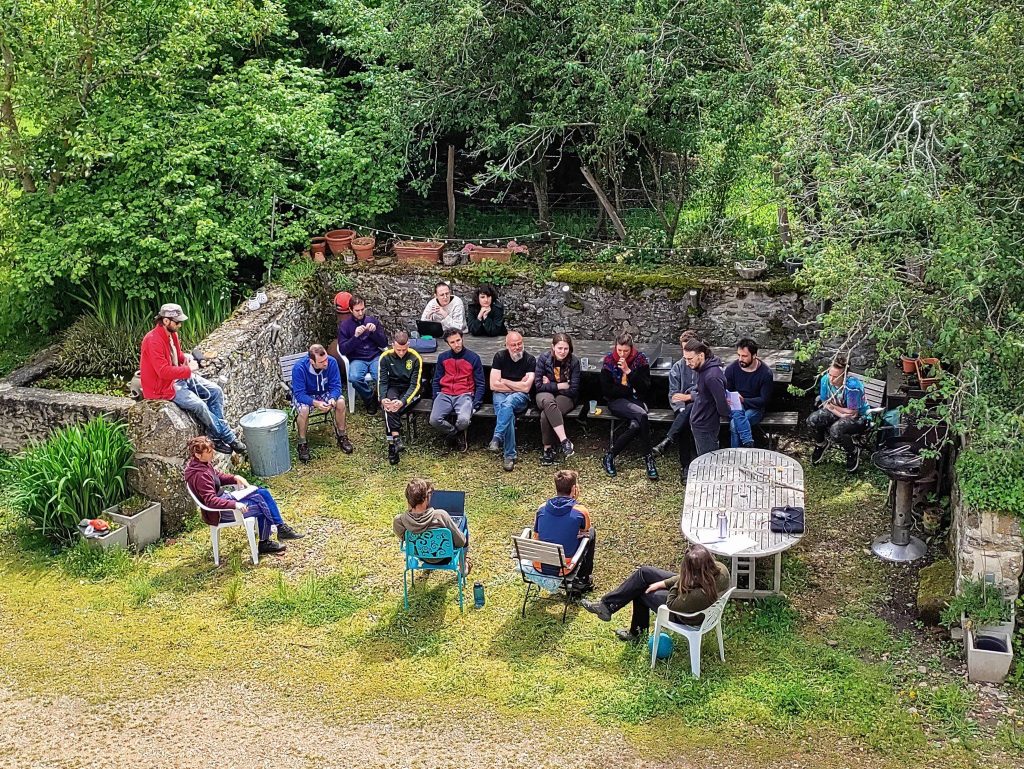
One pinches oneself to believe it, but that is nevertheless ecology according to certain movements which militate in favour of some “energy transition”. By claiming to solve a problem, they aggravate and create others. In France, since the beginning of the 20th century, 67% of wetlands have disappeared, as well as 75% of pollinators. Two hundred species disappear every day in the world, and 92% of large fish have already disappeared, but this is apparently secondary. According to them, the important thing is to secure the energy future of industrial civilization.
If you want to get out of these contradictions, and finally think seriously about how to save what is left of the living on this planet, join Deep Green Resistance.
Featured image by Zac Edmonds on Unsplash All other images in the text are taken by Alec from DGR France.

by DGR News Service | Mar 20, 2023 | ANALYSIS, Culture of Resistance, The Problem: Civilization
Editor’s Note: Today we’re sharing the following brief essays written by members of Deep Green Resistance:
My Favorite Natural Place
When I was about 8 I lived in the mountains and our home was surrounded by tall needly trees.
Not too far from one corner of the home, just slightly down the hill, was a small cluster of boulders. The rocks were situated in such a way that I could just manage to nestle myself 8-year-old self between them.
It was a tiny haven. A mini open-air dwelling and escape from regular life.
The chipmunks would occasionally join me and there we’d sit listening to the trees creaking in the wind.
I haven’t lived in the woods or any place even remotely as wild since. I’ve called cities home for the majority of my life, both before and after that time. And for an embarrassingly long time, I didn’t realize anything was missing from my life.
But somehow I finally realized the errors in my ways. There wasn’t any specific moment in time or place I visited that reminded of what I was missing. But I began to seek out natural refuges wherever I was. And when I took the time to look around me, I saw that beautiful places were everywhere. Not just in the mountains but in the city parks. And at the beach. On the trails near my home. Even my backyard.
If I had to pick just one favorite place in nature anywhere, I think the mountains will always top the list. But actually I like to think that wherever in nature I happen to be is my favorite place.
Why Should We Care About the Planet?
Two thirds of the oxygen in the air we breathe comes from plankton in the ocean. We evolved with nature, shaped by our relationships with the plants and animals around us.
Every cell in our bodies comes from nature. We are made of water, plant and animal, virus and microbe. The bacteria in our gut outnumber our own cells. We are human only in relationship with the more than human world. And it is an honour to be related. To share a connection with the magnificence and intelligence embodied in the diversity of species who are our kin. It is an honour to be an animal on this planet.
I care because I am in love with the natural world. And knowing what I know, I think it is a necessity to protect it. But more than that, it is an act of gratitude. The Earth gives us our very lives. It gives us the most beautiful things we will ever experience. I could work my whole life in activism and never repay the cost of a single breath of ocean air.
How Do We Prepare For What’s Ahead?
We are living in unpredictable times. Whether it’s the threat of nuclear annihilation, economic depression, or ecological collapse, no one can predict exactly what will happen or when. What we do know is that cities and suburbs will not be places humans can live in the long run.
Women need to learn self-defence now. As things become increasingly chaotic, men will look for an outlet for their violence. Those outlets are always women and nature. We can attempt to learn the skills that are necessary for survival in traditional human cultures.
But there are no personal solutions to social problems, which means we need to build communities, we need to organize, and we need to defend the natural world as if our lives depend on it, because they do.
A Culture of Resistance
What does it mean to have a culture of resistance? What does this culture value? What is it resisting, and why? How is it different from the dominant culture?
The culture that we are living in now — a capitalist, industrial society — has certain values that we have been told are important for our well-being. Some of these values are: unlimited growth is good, we can have whatever we want, humans are superior to all other life forms on earth, we can tame the natural world for our own purposes, and the individual is more important than the community.
The problem with these values is that they are unjust and unsustainable. We aren’t living within the natural limits of our planet. We think we can continue to use up everything on the earth, and there will be no consequences. And if there is a problem, technology will solve it.
In the meantime, the population continues to rise, more and more of the earth is being destroyed, and more species are dying every day. People are becoming more alienated from each other. They don’t understand, or don’t want to acknowledge, that industrial civilization is the cause of all this suffering.
A culture of resistance rejects industrial, capitalist values. It fights for the natural world and knows that we are just one of many species that share this earth.
A culture of resistance joins together as a community, and rejects the idea of individualism. No one person is more important than another. We work together to meet our needs. We respect all beings and realize that we are dependent on nature to live. Nobody should be using up all the natural resources, thereby making it very difficult for others — human and nonhuman — to survive. It reminds me of the Buddhist teaching, “Do not take anything that is not freely given.”
A culture of resistance recognizes that the earth is finite. The planet can support a few million people, but not billions. It can provide us with all we need to stay alive and healthy: clean water and air, natural food, and adequate shelter. Other beings on the planet are respected and seen as part of the natural community, not things to be exploited. Hunter-gatherers used to live in harmony with nature for thousands of years, and it was sustainable.
The modern culture we live in today is toxic in so many ways. If we do not resist, it will continue to grow until it collapses under its own weight, causing unimaginable destruction and suffering. We must get rid of industrial civilization. Join the culture of resistance!
Why I Joined Deep Green Resistance
By Iona
When I came across Deep Green Resistance I had no background in environmentalism and no knowledge about the ecological crises our planet was facing, and in many ways I felt like this put me at a disadvantage. But I think it gave me one really important advantage: it meant that I hadn’t yet been taken in by many of the false solutions offered by the mainstream environmental movement.
I hadn’t been primed to believe that my power as an activist was limited to petitions, street protests, reducing my carbon footprint and so on. And it meant that I didn’t already have a strong belief that technologies like wind and solar were solutions for the planet. It quickly became clear to me, through understanding this new analysis, that such technologies can only be seen as solutions in a world in which humans have lost their true connection to the natural world.
I learned that some studies have shown that renewables are expected to be the number one cause of habitat destruction in coming years. So that begs the question, is that what the planet needs? Is that something I can stand by and support?
My hope is that more people start to question some of these mainstream narratives, whether or not they already understand what’s happening to our planet — our home.
I want more people to look at the facts, and be unafraid in making up their own minds how they feel about what they see.
I want more people to feel confident in questioning whether a new form of industry that calls itself “green” is what the planet really needs, whether it’s really what we want to be doing to our home. And whether we think this industrial way of life we’ve all become so used to is really sustainable.










